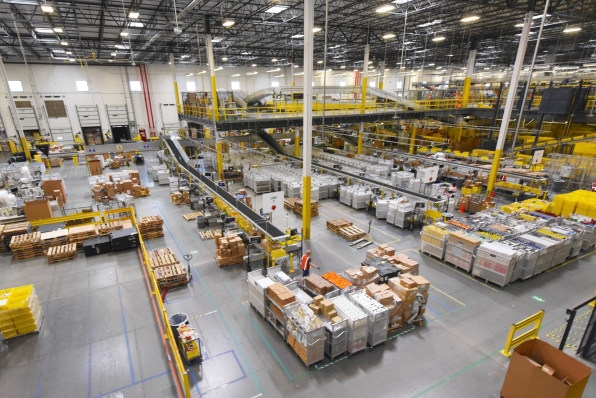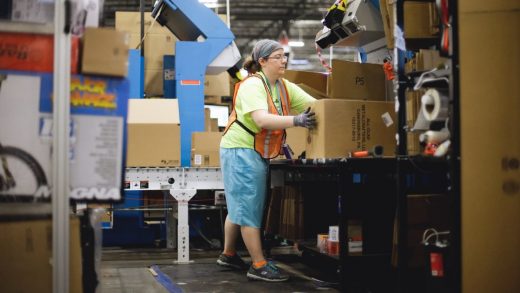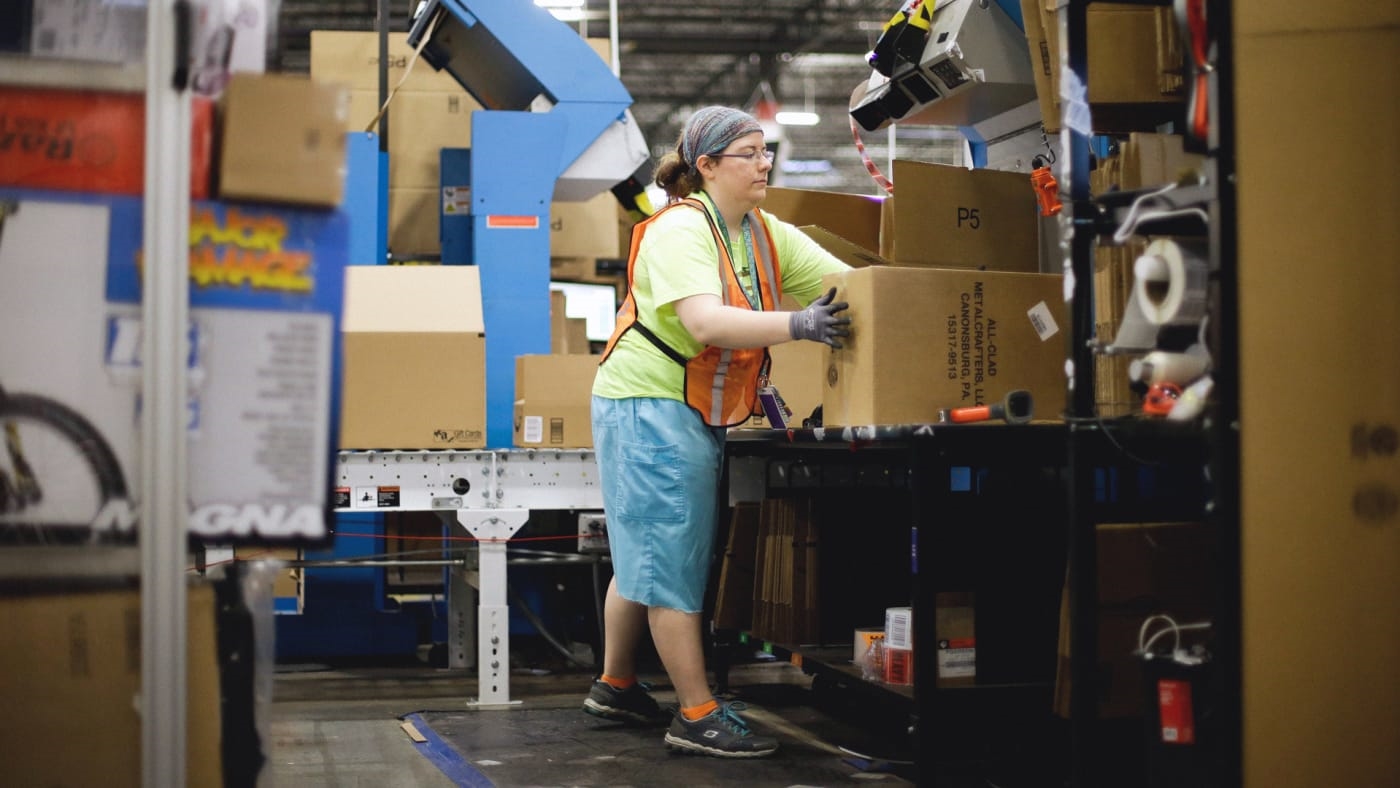What Amazon’s new $15 minimum wage signals for worker pay
When Amazon announced on October 2 that it would be implementing a $15 minimum wage for all of its U.S. workers in the next few weeks–including those hired on a contract or part-time basis–the response hovered between a sense that this was a long time coming, and surprise that it’s happening at all.
For years, Amazon’s treatment of workers has drawn scrutiny. Reports have surfaced that at the tech giant’s warehouses, workers forego restroom breaks to avoid punishment and endure grueling shifts for little pay. They’re given little time off, and required to meet demanding production goals. While full-time fulfillment center workers earn around $15 per hour, according to the company, and are entitled to benefits after a year of work and stock options after two, they often don’t make it that long. Amazon has been less forthcoming about how it pays contract and part-time workers, but it’s likely less. Furthermore, reports have found that there are few benefits to the surrounding community when the company opens a new warehouse nearby. Given that Amazon is valued at over $1 trillion, and its CEO Jeff Bezos is the world’s richest person, the contrast is striking.
But pressure from activists like the Fight for 15 movement, workers, and politicians have turned the heat up under the company to rectify the discrepancy between worker treatment and company profitability. Since Amazon acquired Whole Foods last year, workers at the grocery chain have been pushing to unionize (despite facing opposition from the company). In early September, Bernie Sanders (I-VT) introduced the Stop BEZOS Act–BEZOS coyly stands for “Bad Employers by Zeroing Out Subsidies,” but is very obviously a shot at the Amazon CEO–to call on large companies to raise worker pay.

While the means by which the bill did so were unwieldy and unworkable, says Marshall Steinbaum, research director and fellow at the Roosevelt Institute, a left-leaning think tank, Sanders was essentially trying to convince companies to pay workers more so they wouldn’t have to rely on federal benefits paid for with tax dollars–it was politically effective. Especially in concert with Senator Elizabeth Warren’s (D-MA) Accountable Capitalism Act, which aims to narrow the gap between executive and worker pay, and give regular employees more power in company decisions, it tapped into a larger frustration with Amazon: Why was a company helmed by the richest man in the world, and responsible for almost half of all e-commerce sales, reluctant to create fair labor conditions for its workers?
In part, Steinbaum says, Amazon is just keeping pace with national trends. “There has been little upward wage pressure in the economy, despite the fact that we’ve had relatively low unemployment since the Great Recession,” he says. The fact that ordinary workers have seen barely any meaningful growth in wages in the past four decades, while executive pay continues to grow at a steady rate, reflects many issues in the way that modern companies operate. For one thing, companies are more beholden to their shareholders than their workers; profits are returned to people who own stock in the company, not who keep it running. In turn, it benefits companies to cut costs where they can–often from worker’s salaries–to keep shareholder returns high. The rise of this dynamic tracks with the decline of labor unions, which helped keep the gap between workers and executives in check.
Unions, and the structured, equitable pay scales across companies that they advocated for, Steinbaum says, were especially crucial for large companies like General Motors, which employed thousands of workers across all different functions. When the tech boom began to take off, unions and wage standards felt less urgent for companies that could be run out of a single room by a handful of people on computers. But Amazon’s days as a tech company are long past: Today, Steinbaum says, it represents the modern interpretation of the manufacturing companies that kept working-class people afloat with decent salaries and working conditions–only it’s often cut corners on fulfilling those criteria.
“What’s interesting about Silicon Valley–and I’m including Amazon, even though they’re not technically Silicon Valley–is that those companies have attained a position of great power in the U.S. economy with relatively little in the way of labor market policies because they employ very few workers relative to what companies in similar positions of power would’ve employed in pervious eras,” Steinbaum says. That’s allowed tech companies to focus on hiring relatively few people at high salaries (while contracting out roles like janitor and cafeteria worker, which were once full-time company jobs, to cut costs, which is a separate but related issue). While their role in U.S. culture might be large, their share of the labor market is still fairly small.
Amazon, though, morphed away from that model long ago. It now employs over 250,000 workers year-round, across all its operations, and annually hires 100,000 seasonal workers for the holidays. It’s not a tech company: It’s a tech, operations, logistics, distribution company. “You can’t really operate a business like that unless you have a pay structure more traditionally associated with large, dominant corporations,” Steinbaum says. “That Amazon is now setting a company-specific minimum wage is evidence of its changing character as a company.”
But having said that, Steinbaum adds, “We shouldn’t view this as a sort of natural phenomenon that sort of sprung out of the evolution of the company for random reasons–it’s definitely related to current political pressures.” Not only have there been scores of articles about conditions at fulfillment centers and union-busting tactics within the company, but the search for the company’s second headquarters has highlighted the power the company holds as it demands concessions from cities in exchange for the promise of new jobs. “There’s no way for the company to escape the public eye and the vicissitudes of politics,” Steinbaum says, “and that matters a great deal for wages and other factors of the company.”
That Amazon implemented the $15 minimum wage only after such pressure demonstrates that the company, first and foremost, still wishes to be seen as a tech company, and not a giant corporation akin to its mid-century predecessors; it could also indicate that Amazon really just didn’t believe it needed to pay its people more. As such, the price for the new wage floor is that Amazon is no longer offering long-term warehouse workers stock options. There’s an argument to be made that swapping out stock for a minimum wage may actually save the company money–Amazon’s stock has been booming of late. But if the company were truly invested in worker financial outcomes, they could continue to offer both–and let their workforce unionize to collectively bargain for such benefits.
But shortcomings aside, Steinbaum does not want to minimize the enormity of Amazon’s decision to shift to a $15 minimum wage. Amazon, after Walmart, is the second-largest employer in the U.S. The federal minimum wage of $7.25 per hour has not budged since 2009. By setting their own minimum wage of $15–which several states and employers have already done–Amazon will be creating a major wage lift for many people, and sending a signal to Washington. (As part of its forthcoming wage floor, Amazon has said that it will employ a public policy team to lobby for a higher federal minimum wage.) While the push for higher minimum wage laws will meet with resistance under the current government in Washington, what Amazon’s decision makes clear is that the companies who employ the majority of Americans have the financial resources to see it through, and now they have a pretty significant precedent.
(11)



